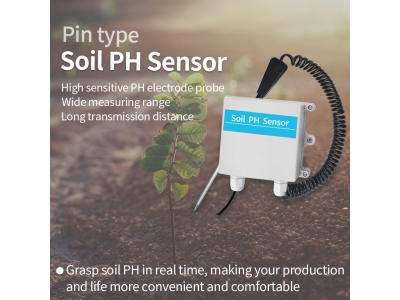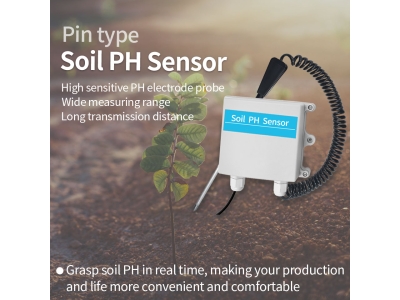Precision agriculture, also known as smart farming, has revolutionized the way we approach agricultural practices. This innovative approach utilizes advanced technologies and data-driven insights to optimize crop production while minimizing the use of resources. One key component of precision agriculture is soil sensors. These sensors provide valuable information about soil conditions, allowing farmers to make informed decisions regarding irrigation, fertilization, and overall crop management. In this article, we will explore the significant role of soil sensors in precision agriculture and how they are transforming modern farming practices.

I. Understanding Soil Sensors:
Types of Soil Sensors: There are various types of soil sensors available in the market, each designed to measure specific soil parameters. Some commonly used soil sensors include:
Moisture Sensors: Measure soil moisture content at different depths, providing information about water availability for plant roots.
Temperature Sensors: Monitor soil temperature, which influences seed germination, nutrient availability, and microbial activity.
Electrical Conductivity Sensors: Assess soil salinity levels, helping farmers manage salt accumulation and prevent crop damage.
pH Sensors: Measure soil acidity or alkalinity, guiding farmers in adjusting soil pH to create optimal growing conditions.
Nutrient Sensors: Determine nutrient levels in the soil, enabling precise fertilization strategies and nutrient management.
Functionality of Soil Sensors: Soil sensors operate by collecting data through probes that are inserted into the ground. These probes contain sensors that measure specific soil parameters. The collected data is then transmitted to a central system for analysis and interpretation.
II. Benefits of Soil Sensors in Precision Agriculture:
Irrigation Management:
Accurate measurement of soil moisture levels through soil sensors allows farmers to optimize irrigation practices. By understanding the water needs of crops at specific growth stages, farmers can avoid over or under-watering, resulting in improved water-use efficiency and reduced water wastage.
Fertilizer Application:
Soil sensors provide insights into nutrient levels, allowing farmers to implement precise fertilizer application strategies. By targeting specific areas with nutrient deficiencies, farmers can minimize fertilizer use while maximizing plant nutrition, reducing costs and environmental impact.
Disease Prevention:
Soil sensors can detect changes in soil conditions that may indicate the presence of diseases or pests. Early detection enables farmers to take timely action, implementing appropriate pest control measures or disease management strategies to prevent crop losses.
Enhanced Crop Quality and Yield:
By continuously monitoring soil conditions, farmers can ensure optimal growing conditions for crops. This leads to improved crop quality and higher yields, as plants receive the necessary nutrients, water, and environmental conditions required for healthy growth.
Resource Efficiency:
Soil sensors enable farmers to precisely manage resources such as water, fertilizers, and pesticides. By only applying these inputs when and where needed, farmers can reduce waste, lower costs, and minimize environmental impacts associated with excessive use.
III. Integration of Soil Sensors with Other Technologies:
Internet of Things (IoT) and Connectivity:
Soil sensors can be connected to the internet, allowing real-time data collection and remote monitoring. This connectivity enables farmers to access soil data through mobile applications or web interfaces, facilitating quick decision-making and on-the-go adjustments.
Data Analytics and Artificial Intelligence (AI):
The integration of soil sensor data with advanced analytics and AI algorithms enables farmers to gain valuable insights and predictions. By analyzing historical data and identifying patterns, farmers can make more accurate predictions about crop growth, disease outbreaks, and yield potential.
Satellite Imaging and Remote Sensing:
Combining soil sensor data with satellite imaging and remote sensing technologies provides a comprehensive view of crop health and soil conditions. This integration allows farmers to monitor large areas of land and identify localized issues, enabling targeted interventions for improved productivity.
IV. Challenges and Future Directions:
Cost and Accessibility:
The initial cost of installing soil sensors can be a barrier for some farmers, especially small-scale producers. However, as technology advances and becomes more accessible, the cost of soil sensors is expected to decrease, making them more widely available.
Data Interpretation and Decision Support:
While soil sensors provide valuable data, the challenge lies in interpreting and utilizing this information effectively. The development of user-friendly software and decision support systems will aid farmers in turning raw data into actionable insights for improved management practices.
ntegration with Autonomous Systems:
The future of precision agriculture lies in the integration of soil sensors with autonomous systems, such as robotic machinery and drones. These systems can collect data from multiple sources, including soil sensors, and autonomously perform targeted actions in the field, further optimizing farming practices.
Conclusion:
Soil sensors play a crucial role in precision agriculture by providing farmers with accurate and real-time information about soil conditions. With the ability to optimize irrigation, fertilization, and disease management practices, soil sensors contribute to increased productivity, resource efficiency, and environmental sustainability. As technology continues to advance, the integration of soil sensors with other technologies will further enhance farming practices, paving the way for a more efficient and sustainable agricultural future.






